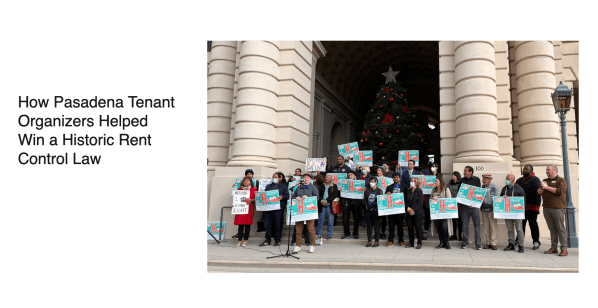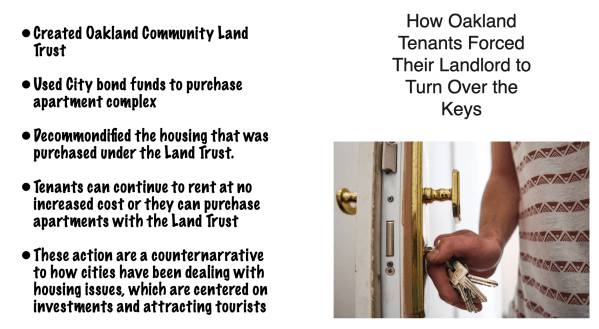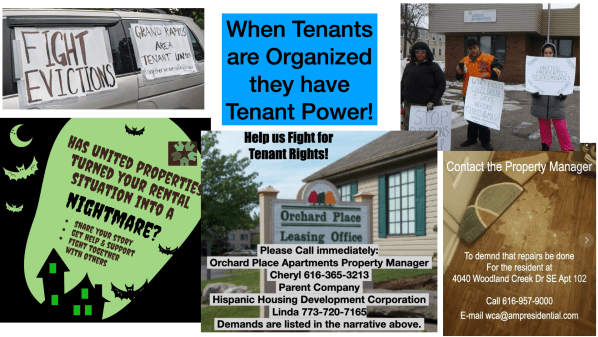Grand Rapids Tenant Assembly successfully got renters together to talk about building a movement centered on building tenant power
On Saturday, roughly 80 tenants and allies gathered in the Linc Up gallery at an event hosted by the Grand Rapids Area Tenant Union and the Community Owned Safety Coalition.
Most of the day was spent in smaller breakout groups, where tenants shared their collective experience as renters, how tenants can collectively organize to win housing justice demands, how to combat the threat of evictions, along with how to work on local and state policies that center housing justice, such as rent control.
As a volunteer organizer with the Grand Rapids Area Tenant Union, since it began in March of 2020, I wanted to share the information I presented to those in attendance at the Tenant Assembly, information that was meant to provide some historical context around the fight for housing justice and how the movement is framing the fight for Tenant Power. What follows is a written form of what I presented, which includes some of the slides I used. To view all the slides go here.
I began by talking about an example of what tenant power can look like, by talking about what a tenant union did in Pasadena, California. (See slide above) In 2022, tenants won comprehensive rent control, including protections from retaliation against tenants who were trying to organize.
Next, I showed a slide headlined What Are We Here for? In that slide I identified what the tenant movement was built on, which included:
- To create Tenant Solidarity – was in which we can support each other as tenants
- To fight against exploitation from Landlords and Property Management Companies
- To demand housing as a human right. This is different than fighting for more affordable housing, since that tactic is woefully inadequate.
- To demand living wages. If we have real living wages which would be enough to cover current rental costs and all of our other expenses within the Capitalist system, then we would not need “affordable housing for a few”
- To build Tenant Power. This is the ultimate goal, with tenant power being the ability to win our collective demands no matter what the housing market tries to impose upon us.
In the 3rd slide, I discussed how we got in the predicament we are in. Again, I included 5 major points, which included:
- We have an economic system of Capitalism that sees housing as a commodity, not as a right for everyone.
- In response to the 2008-2009 economic crash, the US Congress provided a $700 Billion bailout, the primarily went to Wall Street, to large Banks, to Insurers and to the Auto Industry.
- Currently in the US, there are 7.4 million families that live in poverty.
- If Congress had bailed out the 7.4 million families living in poverty, each of those families would have received $94,594.00
- In addition, the 2008-2009 economic crash saw the rise of corporate housing owners, like Blackrock, which alone is worth $120 Billion. See the report Wall Street Landlords turn American Dream into a Nightmare.
In the fourth slide, I went back to looking at another tenant victory, this time in Asheville, North Carolina. Included here is a great flyer from the community in Asheville, along with what they won.
After discussing another concrete tenant victory, I then showed this graphic, which comes from the National Low Income Housing Coalition, which tracks the cost of rent in every state along with the average cost in cities like Michigan. You see here that they note that in the Grand Rapids area, for people to afford the cost of rent for a 2-bedroom apartment, you would have to earn $25.50, just to cover your rent costs each month.
Building on the wealth disparity in the cost of housing across the US and in the Grand Rapids area, I then talked about the wealth gap that exists in this community, using the wealth of the Meijer family as an example. According to a recent Forbes posting about family wealth in the US, the Meijer family is one of the richest in the country with $16.5 Billion collectively. In the slide below, I broke down how the $1.5 billion they made in the past year could be used for new housing or how many families could pay rent for a year with the $1.5 billion. Of course, the Meijer family would still have $15 billion and it seems reasonable that they would still be able to live comfortably off that amount.
I then looked at wealth and spending realities through the lens of the Lyon Square Project, which is a beautification project that will happen between the Amway Grand Plaza and the old Welsh Auditorium. The Lyon Square Project with cost $12 million, which if redirected to real housing needs would provide what the slide shows.
A third example of tenant power that we looked at was from Oakland, California, which shows a tenant victory through organizing a Community Land Trust.
The OakCLT (Oakland Community Land Trust purchased the building for $3.3 million dollars using municipal bond funds from Oakland’s Measure KK, an infrastructure bond passed in 2016. The use of municipal infrastructure bond funds for the decommodification of housing indicates an emerging commitment to the preservation of affordability as well as a recognition that homes, and existing tenants of those homes, are part of the city’s critical infrastructure — a testament to years of hard work put in by tenants and organizers. (Although the funding available under Measure KK has run out, ACCE and other organizations are campaigning for another housing and infrastructure bond measure that will be on the ballot in November.) It’s also a departure from the last forty years of entrepreneurial city governance that has prioritized for-profit projects and policies strategically designed to attract investment, encourage economic growth, and improve the city’s standings with bond-rating agencies over public need.
In the slide above I talked about what I call the Non-Profit Housing Industrial Complex. The organizations listed in the slide are not “bad,” rather none of them work on addressing the root causes of the housing crisis, which for the Grand Rapids Area Tenant Union are the commodification of housing and economic inequity or the wealth gap in Kent County. However, I did point out that the group Housing Next, which was created by the Grand Rapids Area Chamber of Commerce, does do tremendous harm, since they are currently controlling the narrative around housing in Kent County, a narrative that promotes a market rate ideology. The slide below lists the so-called Community Partners of Housing Next, which is why they embrace a market narrative around housing.
In the final slide, I showed a montage of images from the Grand Rapids Area Tenant Union’s work over the passed for years, which was centered on confronting landlords and Property Management Companies and some of the local victories that have been won.
If you are interested in getting involved in the Grand Rapids Area Tenant Union or the Movement for Tenant Power, contact the tenant union at gratunion@gmail.com or through their Facebook page.








Trackbacks
Comments are closed.